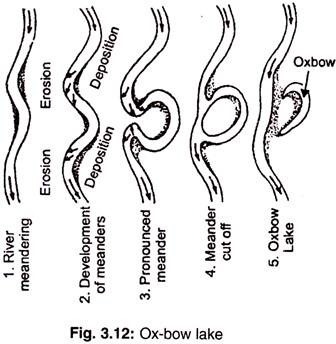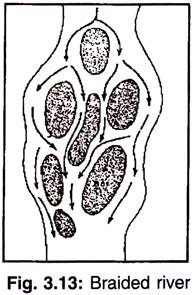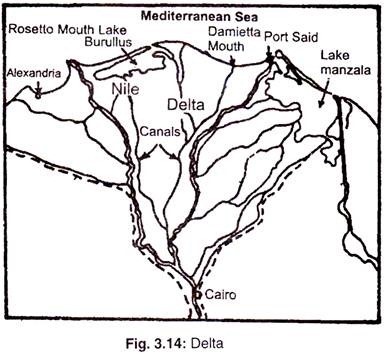ADVERTISEMENTS:
In this article we will discuss about:- 1. Definition of Air Pressure 2. Factors Affecting Air Pressure 3. Distribution.
Definition of Air Pressure:
Distribution of temperature is not similar at all the places on the Earth. Because of difference in temperature, air pressure also varies immensely.
Weight of air is known as air pressure. Air is a composition of various gases therefore it has specific weight. Weight of air on any unit of area on Earth is known as air pressure while it is represented in Millibar unit. Air expands in summer due to high temperature and in winter it shrinks due to low temperature.
ADVERTISEMENTS:
High temperature causes scanty air and less air pressure while low temperature brings thick air and higher air pressure. Thus difference between air pressures creates air movement from high pressure areas to low pressure areas which is known as wind.
Temperature and Air pressure cause expansion and shrinking of air which further results into distribution of heat and moisture in the atmosphere. In normal circumstance average air pressure at sea level is 1013.2 milibar. Instrument used to measure air pressure is known as Barometer.
 Factors Affecting Air Pressure:
Factors Affecting Air Pressure:
1. Temperature:
As the temperature increases, air expands because of which its density decreases which results in low pressure. On the other hand air shrinks due to low temperature because of which its density increases which creates high pressure.
The relation between air pressure and temperature is defined with following quote- “When the mercury of thermometer rises, mercury of barometer falls”. Equatorial regions have low pressure because of high temperatures. On the other hand Polar regions have high pressure due to low temperature.
ADVERTISEMENTS:
2. Height from Sea Level:
Air pressure is created due to weight of air therefore sea level has highest air pressure. As we move upward from sea level leaving behind the heavy gases at lower layers of atmosphere, air pressure decreases because the upper air is light and its density is low.
There is no fixed rate of fall in air pressure with increase in height but it decreases with increase in height. Air pressure is reduced to half at the height of 5 Kms from seal level and at the height of 11 kms it is reduces to one fourth. It is because of low pressure in mountainous regions that breathing gets hard.
ADVERTISEMENTS:
3. Moisture in Air (Humidity):
Conversion of water from liquid state to gaseous state because of evaporation is known as atmospheric humidity. Water vapours are light in weight therefore they rise up and pressure of humid air decreases as compared to dry air. Amount of water vapours changes with time and place and because of this the pressure of air also varies.
4. Gravitation of Earth:
Atmosphere glues around the Earth due to its gravitation. The intensity of gravitational pull decreases as we get away from core of Earth. Another fact is that as Earth rotates round its axis, average distance of Polar Regions and equatorial regions varies from the core of Earth. For example Polar Regions are nearer to core of the Earth as compared to Equatorial regions and hence have higher air pressure.
5. Rotation of Earth:
Rotation of Earth produces centrifugal force which has more effect in Equatorial region while lesser effect on Polar regions. Centrifugal force Pushes things away from its core. Same is the effect on air pressure which results into lesser pressure in Equatorial regions as compared to that in polar regions.
Distribution of Air Pressure:
As air is present all around the Earth, it may be distributed in to ways namely; horizontally and vertically.
1. Horizontal Distribution:
Air pressure of a particular place changes with day and night, with summer and winter but average air pressure conditions remain same generally. If we study the division of air pressure on Earth then we will come to know there are various high and low pressure regions. On maps these divisions are shown with help of isobars.
ADVERTISEMENTS:
Generally air pressure is divided into two types:
a. High pressure.
b. Low pressure.
On the basis of combined affect of various factors affecting the air pressure on different latitudes seven air pressure belts are found on the Earth.
Equatorial low pressure belt region extending between 5°N latitude of Equator to 5°S latitude is known as Equatorial low pressure belt.
Following are the reasons which are responsible for its origin:
(i) Rays of sun fall vertically in this region whole the yearlong and because of this temperature is high which creates low pressure.
(ii) Owing to high temperature, evaporation process is also very fast while large number of water vapours decreases the weight and density of air resulting in reduction of air pressure.
(iii) Rotation of Earth has its maximum effect on Equator and so is effect of centrifugal force which results into reduction in air pressure.
At about 30°N and 30°S latitudes high pressure regions are found in both hemispheres which are formed with descending winds on this latitudes risen up at hot Equatorial regions. Further at 60°N and 60°S latitudes low pressure regions are found. At poles high pressure regions are formed because temperature remains low for whole of the year.
It is important to mention that these belts are not stable. They shift according to the situation of sun as on earth. e.g. During winters (December) in northern hemisphere, sun rays fall vertically on the tropic of Capricorn. During these pressure belts shift towards south. On the other hand situation is opposite in summer.
2. Vertical Division:
As we already know, air pressure on Earth exists due to pressure of upper layers. Atmosphere extends upto the height of hundred kilometers from the Earth surface. Air pressure is highest at sea level because the density of gases is highest in lower layers.
Density changes due to the expansion and the air shrinks because of low temperature. Air pressure and height are reversely proportional to each other, which means air pressure decreases due to increase in height. But the rate of fall in air pressure decreases with increase in height.
Fast blowing winds originate due to the difference between air pressures at earth surface but on the other hand air pressure decreases as the height increases in spite of this we do not feel fast blowing upward winds. The reason behind this is that the gravitational force of Earth also decreases with increase in height.


